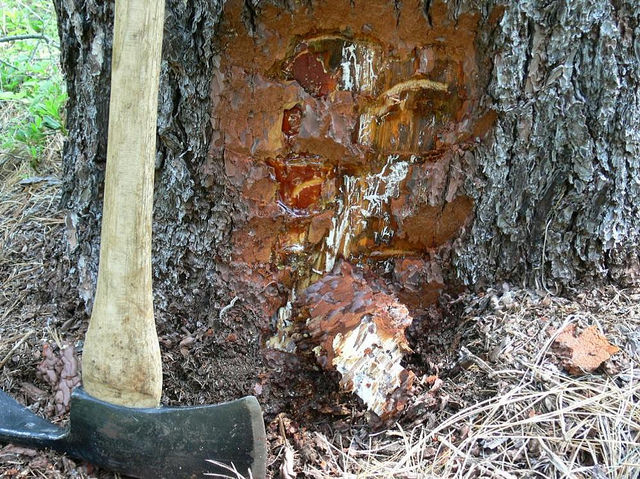This is the second part of a series on fall tree diseases and disorders. This article examines armillaria root rot and apple scab.
Introduction
During fall, the environment undergoes a drastic shift, with cool temperatures prevailing, and inclement weather often abundant. In this climate, many plant diseases flourish. The following describes some of the most common plant diseases to occur in fall, and how they affect their hosts.
Armillaria Root Rot (Armillaria)
Armillaria root rot, also called fungal root rot, or Armillaria root disease, is a plant disease caused by several members of the genus Armillaria. The fungus most often identified as the causal agent is Armillaria mellea. Several closely related species may also infect susceptible plants. Fungi are natural components of forests, where they reside on the coarse roots, and lower stems of conifers and broad-leaved trees. Armillaria fungi act as parasites, infecting trees, and causing the inner wood tissue to decay. Infected trees often decline, with many eventually succumbing to the disease.
Hosts
Armillaria root rot infects hundreds of species of trees, shrubs, vines, and forbs growing in forests, along roadsides, and in landscape settings. Larch and birch are the only trees that exhibit resistance to the disease.
Symptoms
Armillaria fungi typically inhabit roots. Mushrooms may be found growing in clusters around the base of infected trees and stumps. Mushrooms are produced sporadically from late summer to fall. They are most abundant during moist periods. Mushrooms have yellow or brown stalks around two inches long. Some mushrooms form a ring around the stalk just below the gills. Stalks have yellow caps that are two to five inches in width. The upper side of the cap is laden with dark brown scales, and may be slightly sticky. The underside of the cap features light-colored gills, which produce millions of light yellow to white spores. During wet periods in late summer and fall, these spores are released into the air, where they are disseminated by the wind onto nearby plants.
Crown symptoms on conifers and broad-leaved trees vary. Generally, the foliage thins and becomes discolored, turning yellow before finally browning. Shoot and branch die back may occur, with foliar growth significantly reduced. On large, vigorous trees, crown symptoms develop gradually over several years. Broad-leaved trees may form sunken cankers on infected limbs and branches. These cankers are covered with loose bark, or bark infiltrated with resin. Conifers, particularly Douglas-fir and western larch, frequently produce an abnormally large crop of cones, referred to as stress cones, as they decline. On most conifers, the infected portions of the lower stem will enlarge, and exude resin. The infected portions of the roots often become encrusted with resin, soil, and fungal tissue. On stressed or weakened trees, crown symptoms develop rapidly, with the tree often succumbing to the disease within a year.
Removing the bark on infected trees will reveal white mycelial mats on the rhizomorphs that form between the wood and the bark. Rhizomorphs also grow through the soil, becoming entwined with healthy roots. Rhizomorphs are black or reddish brown, with a compact outer layer of dark mycelium, and an inner core of white mycelium. The thick mycelial mats on the rhizomorphs decompose, leaving impressions on the inner bark.
Stripping the bark away may also reveal a white rot of infected wood. When the decay process first begins, infected wood turns light brown, and looks faintly water soaked. As the decay advances, the infected wood turns light yellow or white, and may be marked by numerous black lines. In hardwoods and conifers, the texture of decayed wood varies. Decayed wood is spongy in hardwoods, but stringy in conifers.
Trees that are suffering from drought stress, or have incurred injuries through mechanical wounding, insects, or other fungi may produce symptoms associated with those caused by Armillaria fungi.
Management
- Armillaria root rot cannot be completely eradicated. Management should be directed towards limiting the buildup and spread of the disease.
- Chemical fumigants, including chloropicrin, methyl bromide, and carbon disulfide may be applied to reduce infection levels. Fumigants should be applied in and around the base of infected stems, or in perforations created in the soil after trees have been removed.
- When planting, select a mixture of species that exhibit a resistance to Armillaria fungi.
- Maintain tree vigor through sound cultural practices. Ensure that trees are sufficiently watered, especially during dry periods. Apply a layer of organic mulch around the base of trees to improve soil quality, moderate soil temperature, and retain soil moisture.
- Uproot infected or susceptible root systems and stumps to reduce the number of food sources available to Armillaria fungi.
Apple Scab
Apple scab is a fungal disease that commonly infects various apple and crabapple trees. It is recognized as one of the most significant diseases of apples and crabapples. It is caused by the ascomycete fungus Venturia inaequalis. Apple scab infections are capable of disfiguring trees. Severe infections may also reduce or eliminate fruit yield for a single growing season.
Hosts
The apple scab pathogen primarily infects apples and crabapples. Infections may also occur on hawthorns, mountain ash, firethorn, and loquat.
Symptoms of Infection
Infections are generally most conspicuous on leaves and fruit. Lesions initially become apparent in spring. They may be observed on the underside of expanding leaves. As the leaves develop, the upper surface becomes vulnerable to infection. Lesions first appear as light green sections on infected leaves. Lesions are generally circular in shape. As the growing season progresses, the lesions enlarge, and deepen in color. Lesions that form on young leaves may exceed 1 cm in diameter. Older leaves are more resistant to infection. Lesions that are observed on older leaves tend to be smaller. Infected leaves will often become distorted, with the lesions appearing cracked and torn. Many infected leaves will be prematurely shed, resulting in significant defoliation of the host. Successive defoliations can reduce tree vigor, rendering trees more prone to insect infestations, and infiltration from additional disease pathogens.
Symptoms on plant blossoms are usually characterized as small, dark green lesions at the base of the flower, on the sepals, and on the stem pedicel. Extensive infection of flowers pedicels may cause developing fruit to drop, resulting in a lower fruit yield. The first noticeable symptom of infection on fruit is the appearance of water-soaked areas, which coalesce to form green to brown lesions. Infections of young fruit will often result in fruit distortion. Severely infected fruit may be malformed.
Management
- Many varieties of apple and crabapple are partially resistant or immune to apple scab. Resistant varieties of apple include ‘Dayton’, ‘Freedom’, ‘Honeycrisp’, ‘Liberty’, ‘McShay’, ‘Pristine’, ‘Pixie Crunch’, ‘Redfree’, and ‘William’s Pride’. Varieties of crabapple that exhibit resistance to apple scab include ‘Adams’, ‘Adirondack’, ‘Baskatong’, ‘Bob White’, ‘Calocarpa’, ‘Candywhite’, ‘Christmas Holly’, ‘Coralburst’, ‘David’, ‘Donald Wyman’, ‘Firebird’, ‘Harvest Gold’, ‘Indian Magic’, ‘Indian Summer’, ‘Jewelberry’, ‘Lollipop’, ‘Louisa’, ‘Malus x zumi’, ‘Mary Potter’, ‘Molten Lava’, ‘M. Floribunda’, ‘M. halliana var. parkmanii’, ‘Prarie Maid’, ‘Prariefire’, ‘Purple Prince’, ‘Red Jewel’, ‘Robinson’, ‘Royal Beauty’, ‘Tina’, ‘Sargent’, ‘Silver Moon’, and ‘Strawberry Parfait’.
- Susceptible trees require fungicide sprays every year to control the apple scab fungus. Chemical fungicides are generally utilized for two purposes: as a preventative practice, or as a curative tool. Preventative fungicides are sprayed on the leaves and fruit prior to infection. Fungicidal applications prevent the fungal spores from effectively germinating, or penetrating the host tissue. Curative fungicides express limited systemic activity. If applied shortly after infection, curative fungicides may hinder development of the fungus, limiting disease progression. Initial applications should be performed in spring, as leaf expansion begins. Applications should continue until mid-June, when petal drop occurs. During this period, susceptible foliage and fruit should be inspected for scab lesions. If no leaf spots are present, applications may cease. If scab lesions are detected, applications should proceed until the end of summer. Refer to fungicide labels to determine the recommended spray interval.
- Rake and dispose of fallen leaves in autumn. Infected leaves can be burned or buried.
- Prune trees periodically to improve air circulation throughout the crown. Remove vigorous water sprouts that have formed along the main trunk, or within the canopy to increase sun penetration, and promote rapid drying of the leaves following rainstorms. This will help to create an environment that is less favorable to infection.


